

Don't Expect Anyone to Tell You About These 4 Rock Solid Innovation Principles, But They Are Absolutely Crucial. Every enterprise needs to innovate.
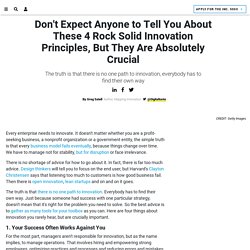
It doesn't matter whether you are a profit-seeking business, a nonprofit organization or a government entity, the simple truth is that every business model fails eventually, because things change over time. We have to manage not for stability, but for disruption or face irrelevance. There is no shortage of advice for how to go about it. In fact, there is far too much advice.
Design thinkers will tell you to focus on the end user, but Harvard's Clayton Christensen says that listening too much to customers is how good business fail.
What You Need to Know Before Pursuing a Center for Innovation. We recently interviewed Dr.
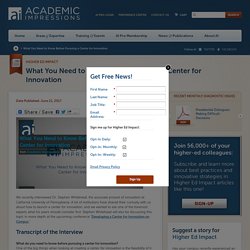
Stephen Whitehead, the associate provost of innovation at California University of Pennsylvania. A lot of institutions have shared their curiosity with us about how to launch a center for innovation, and we wanted to ask one of the foremost experts what his peers should consider first. Stephen Whitehead will also be discussing this topic in more depth at the upcoming conference "Developing a Center for Innovation on Campus. " The Essential Innovation Checklist - Eduventures. By Cara Quackenbush, Vice President of Research When it comes to innovation, why is it that some organizations struggle to escape internal inertia?
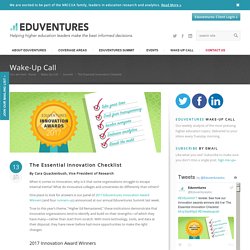
What do innovative colleges and universities do differently than others? One place to look for answers is our panel of 2017 Eduventures Innovation Award Winners (and four runners-up) announced at our annual Eduventures Summit last week. True to this year’s theme, “Higher Ed Remastered,” these institutions demonstrate that innovative organizations tend to identify and build on their strengths—of which they have many—rather than start from scratch. With more technology, tools, and data at their disposal, they have never before had more opportunities to make the right changes.
Innovative Ideas - Make Room for Old Ideas. “Not all ideas are new.
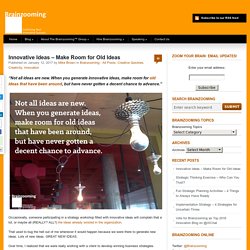
When you generate innovative ideas, make room for old ideas that have been around, but have never gotten a decent chance to advance.” Occasionally, someone participating in a strategy workshop filled with innovative ideas will complain that a lot, or maybe all (REALLY? ALL?) The ideas already existed in the organization. A simple rule for innovation – Medium. Trying to innovate turns out to be stressful at times.

Especially being a Designer, I am usually challenged to bring out creative and new ideas. Most often, we come up with beautiful and innovative ideas, only to find (with a Google search) that the idea was already thought of and developed by someone. I try to explain here a simple rule for innovation (more like a rule of thumb) which could be used by innovators, people looking for fresh ideas, PHD candidates, entrepreneurs looking for fresh startup ideas, people thinking of what projects to do, and of course people who want to publish or patent something new. Let’s call it the “s.in rule” (short for simple innovation rule). Invent Health: A jolt of inspiration/innovation for health care. The Chief Technology Officer at the U.S.

Department of Health and Human Services (HHS) is, in a lot of ways, the chief innovation officer. My team brings a can-do, creative spirit to HHS that a lot of people associate with startup companies. What I can tell you now that I’ve been in the job for over a year is this: the passion, tenacity, and creativity that we associate with entrepreneurs can be found in government agencies. It can also be found in communities of people living with rare, life-changing, or chronic health conditions. The fire in the belly burns just as strongly among patients and caregivers as it does among startup founders. When I arrived at HHS last year, I brought with me the spirit of the empowered patient movement. How Innovative Ideas Arise – The Mission – Medium. How Innovative Ideas Arise In 2010, Thomas Thwaites decided he wanted to build a toaster from scratch.
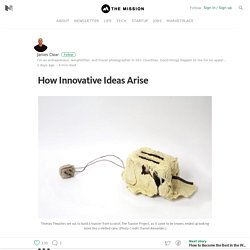
He walked into a shop, purchased the cheapest toaster he could find, and promptly went home and broke it down piece by piece. Thwaites had assumed the toaster would be a relatively simple machine. By the time he was finished deconstructing it, however, there were more than 400 components laid out on his floor. The toaster contained over 100 different materials with three of the primary ones being plastic, nickel, and steel. He decided to create the steel components first. Surprisingly, they agreed. The Toaster Project The victory was short-lived. 10 Innovation Barriers Lurking in Your Organization. Is your organization struggling to deliver on the innovation expectations you have for it?
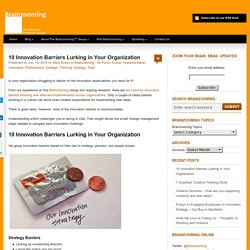
From our experience at The Brainzooming Group and ongoing research, there are ten common innovation barriers blocking new idea and implementation across organizations. Only a couple of these barriers existing in a culture can block even modest expectations for implementing new ideas. There is good news, however: none of the innovation barriers is insurmountable. Understanding which challenges you’re facing is vital. That insight drives the smart change management steps needed to navigate each innovation challenge. 10 Innovation Barriers Lurking in Your Organization.
What do you think you’re doing? — Innovating? The Educational Buzzword Dilemma: Why “Innovation” is about to Jump the Shark. The Educational Buzzword Dilemma: Why “Innovation” is about to Jump the Shark Over the past few years I’ve seen a ton of hype for the term “innovation” when it comes to “transforming education.”
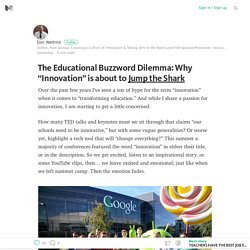
And while I share a passion for innovation, I am starting to get a little concerned. How many TED talks and keynotes must we sit through that claims “our schools need to be innovative,” but with some vague generalities? Or worse yet, highlight a tech tool that will “change everything?” This summer a majority of conferences featured the word “innovation” in either their title, or in the description.
So, lets talk about what we can do now. So here are some (deliberately brief) points I feel we should ponder moving forward: Create a Culture of Innovation Before Day One. “If you always do what you always did, you will always get what you always got.”Albert Einstein’s simple words are a reminder that if we want to witness change, succeed and move forward, we have to do things differently.
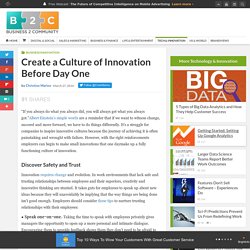
It’s a struggle for companies to inspire innovative cultures because the journey of achieving it is often painstaking and wrought with failure. However, with the right reinforcements employers can begin to make small innovations that one daymake up a fully functioning culture of innovation. Discover Safety and Trust Innovation requires change and evolution. In work environments that lack safe and trusting relationships between employees and their superiors, creativity and innovative thinking are stunted. . ● Speak one-on-one. . ● Be aware. . ● Be transparent. . ● Put meaning behind what you say. How about some actual innovation: Inventing the transistor and landing a nuclear robot on Mars.
How about some actual innovation: Inventing the transistor and landing a nuclear robot on Mars A meandering walk through innovation that also reviews a book I care deeply about innovation. It is literally where the future comes from, but it is a curious thing. Crafting the Ideal Innovation Portfolio. Crafting the Ideal Innovation Portfolio When pursuing innovation initiatives, one of the most important considerations is the makeup of your “innovation portfolio.” Just as an improperly balanced portfolio can increase risk and minimize gains in investing, so too can the wrong makeup of innovation initiatives create unnecessary risk or reduce return on investment. But what is the best approach when considering the makeup of an organization’s innovation portfolio? There are several approaches, but the framework we’ve found most useful is the Three Horizon’s of Innovation, pioneered by Steve Coley, Mehrdad Baghai and David White.
The idea is that to effectively innovate, and achieve consistent organizational growth, an organization needs to simultaneously think and invest at three levels. Defend the Base The first horizon is where mature businesses live. Three Lessons On Innovation I Learned During My 12 Years At Apple. Three Lessons On Innovation I Learned During My 12 Years At Apple As one veteran of Apple’s early forays into digital music explains, nothing slows things down like seeking consensus.
Before Apple Music, before the iPad, even before the mp3, I had a front-row seat and backstage access to the digital music revolution. During my 12-year tenure at Apple, from the late ’80s and to the early 2000s, I helped lead the team that launched some of Apple’s earliest innovations in music and entertainment. We developed the strategies, marketing initiatives, and relationships with content creators and media companies — across music, film, and TV — that laid the foundations that iTunes and subsequent innovations were later build upon.
7 Things Higher Education Innovators Want You to Know. Education Trends 7 Things Higher Education Innovators Want You to Know Experts weigh in on the challenges of student success and the need for innovation in higher ed. In order to close the growing achievement gap, higher education institutions need to focus on innovation, scale and diffusion, according to Bridget Burns, executive director for the University Innovation Alliance, a coalition of 11 public research universities committed to improving graduation rates and sharing best practices. And most important, institutions need to communicate about what works and what doesn't. "Otherwise we are sentencing other universities to repeat our mistakes and our failures — and students deserve better," she exhorted.
Burns spoke last week at SXSWedu as part of a panel of eight higher ed leaders grappling with the challenges of student success. Generating Ideas at Apple. Generating Ideas at Apple The creative process is mythicized in our culture. Know (and Value) The Difference Between Routine and Innovative Work — Page19 Magazine. Innovative Work Purpose: To create entirely original ideas and products.Product: First-of-kind objects or concepts — the light bulb, the iPhone. Heck, even fire.Philosophy: Experimentation; mistakes are encouraged along with wild ideas. The New MBA: A Masters in Business Ambiguity. Most Innovative Schools. Bring More Science To Innovation — Jobs To Be Done.
Dr. Richard Feynman, Nobel Prize winner in Physics says: “Now a question of the form: If I do this, what will happen? Leading Ed Tech Innovation and Change-Campus Tech 2014.